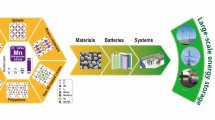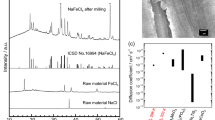Abstract
Exploring novel metal-metal batteries with a facile manufacturing process and low production cost is crucial for the development of next-generation energy storage systems. In this work, the electrochemical performance of a novel Cu–Na battery with Cu foil as a cathode and Na foil as an anode is explored for the first time. The Cu–Na battery exhibits good electrochemical reaction reversibility and cycling stability, which delivers a Coulombic efficiency of 61.5% under a charge capacity limitation of 0.02 mA h cm− 2 with a current density of 0.01 mA cm− 2 after 50 cycles. EIS analysis reveals that the Cu–Na battery maintains a stable electrochemical reaction resistance upon repeated cycles. The present work demonstrates that this Cu–Na battery could be a promising candidate for the next-generation energy storage system.
Graphical Abstract




Similar content being viewed by others
References
H. Wang, Y. Sun, M. Li, G. Li, K. Xue, Z. Chen, D. Yu (2020) Engineering solvation complex-membrane interaction to suppress cation crossover in 3 V Cu-Al battery. Small. 16: e2003438. https://doi.org/10.1002/smll.202003438
J. Yao, Y. Li, R.C. Massé, E. Uchaker, G. Cao (2018) Revitalized interest in vanadium pentoxide as cathode material for lithium-ion batteries and beyond. Energy Storage. Mater. 11 205–259. https://doi.org/10.1016/j.ensm.2017.10.014
H. Wang, K. Xue, B. Su, D. Yu (2021) Achieving reversible Cu-Al batteries by reducing self-discharge and side reactions. Electrochim. Acta. 388: 138595. https://doi.org/10.1016/j.electacta.2021.138595
H. Wang, D. Yu (2019) 3 V Cu-Al rechargeable battery enabled by highly concentrated aprotic electrolyte. ACS Appl. Energy Mater. 2: 4936–4942. https://doi.org/10.1021/acsaem.9b00627
K. Xue, Y. Zhao, P. Lee, D. Yu (2022) Poly(ionic liquid) as an anion exchan-ge membrane for a 3.3 V copper-lithium battery. Energy Environ. Mater. https://doi.org/10.1002/eem2.12395
H. Wang, C. Wang, M. Zheng, J. Liang, M. Yang, X. Feng, X. Ren, D. Yu, Y. Li, X. Sun (2023) A shuttle-free solid-state Cu-Li battery based on a sandwich- structured electrolyte. Angew. Chem., Int. Ed. 135: e202214117 https://doi.org/10.1002/anie.202214117
C. Vaalma, D. Buchholz, M. Weil, S. Passerini (2018) A cost and resource analysis of sodium-ion batteries. Nat. Rev. Mater. 3: 4. https://doi.org/10.1038/natrevmats.2018.13
H. Lin, Z. Zhang, Y. Wang, X. Zhang, Z. Tie, Z. Jin (2021) Template-sacrificed hot fusion construction and nanoseed modification of 3D porous copper nanoscaffold host for stable-cycling lithium metal anodes. Adv. Funct. Mater. 31: 2102735. https://doi.org/10.1002/adfm.202102735
H. Wang, D. Yu (2019) Stainless steel as low-cost high-voltage cathode via stripping/deposition in metal-lithium battery. Electrochim. Acta. 298: 186–193. https://doi.org/10.1016/j.electacta.2018.12.064
Y. Li, W. Xu, T. Sun, J. Yao (2023) Preparation and sodium storage performance of 2D bilayered V2O5⋅nH2O nanomaterial with Zn2+ intercalation. J. Electroanal. Chem. 937: 117416. https://doi.org/10.1016/j.jelechem.2023.117416
W. Xu, Y. Li, J. Yao, Q. Zhu, B. Liu (2022) Lithium storage behavior and mechanism of hexagonal FePO4/C composite as a novel anode material for lithium-ion batteries. J. Alloy. Compd. 933: 167766. https://doi.org/10.1016/j.jallcom.2022.167766
Acknowledgements
This work is supported by the Guangxi Natural Science Foundation of China (2015GXNSFGA139006).
Author information
Authors and Affiliations
Contributions
WX: Investigation, Writing – original draft. YL: Conceptualization, Methodology, Writing – review & editing. JY: Conceptualization, Methodology, Writing – review & editing. JJ: Helped to discuss partial experimental data. QZ: Helped to discuss partial experimental data. All authors reviewed the manuscript.
Corresponding authors
Ethics declarations
Competing of interests
The authors declare that they have no known competing financial interests or personal relationships that could have appeared to influence the work reported in this paper.
Additional information
Publisher’s Note
Springer Nature remains neutral with regard to jurisdictional claims in published maps and institutional affiliations.
Supplementary Information
Below is the link to the electronic supplementary material.
Rights and permissions
Springer Nature or its licensor (e.g. a society or other partner) holds exclusive rights to this article under a publishing agreement with the author(s) or other rightsholder(s); author self-archiving of the accepted manuscript version of this article is solely governed by the terms of such publishing agreement and applicable law.
About this article
Cite this article
Xu, W., Li, Y., Yao, J. et al. Explore the electrochemical performance of a novel metal copper–sodium battery. J Appl Electrochem 53, 1953–1957 (2023). https://doi.org/10.1007/s10800-023-01904-0
Received:
Accepted:
Published:
Issue Date:
DOI: https://doi.org/10.1007/s10800-023-01904-0




